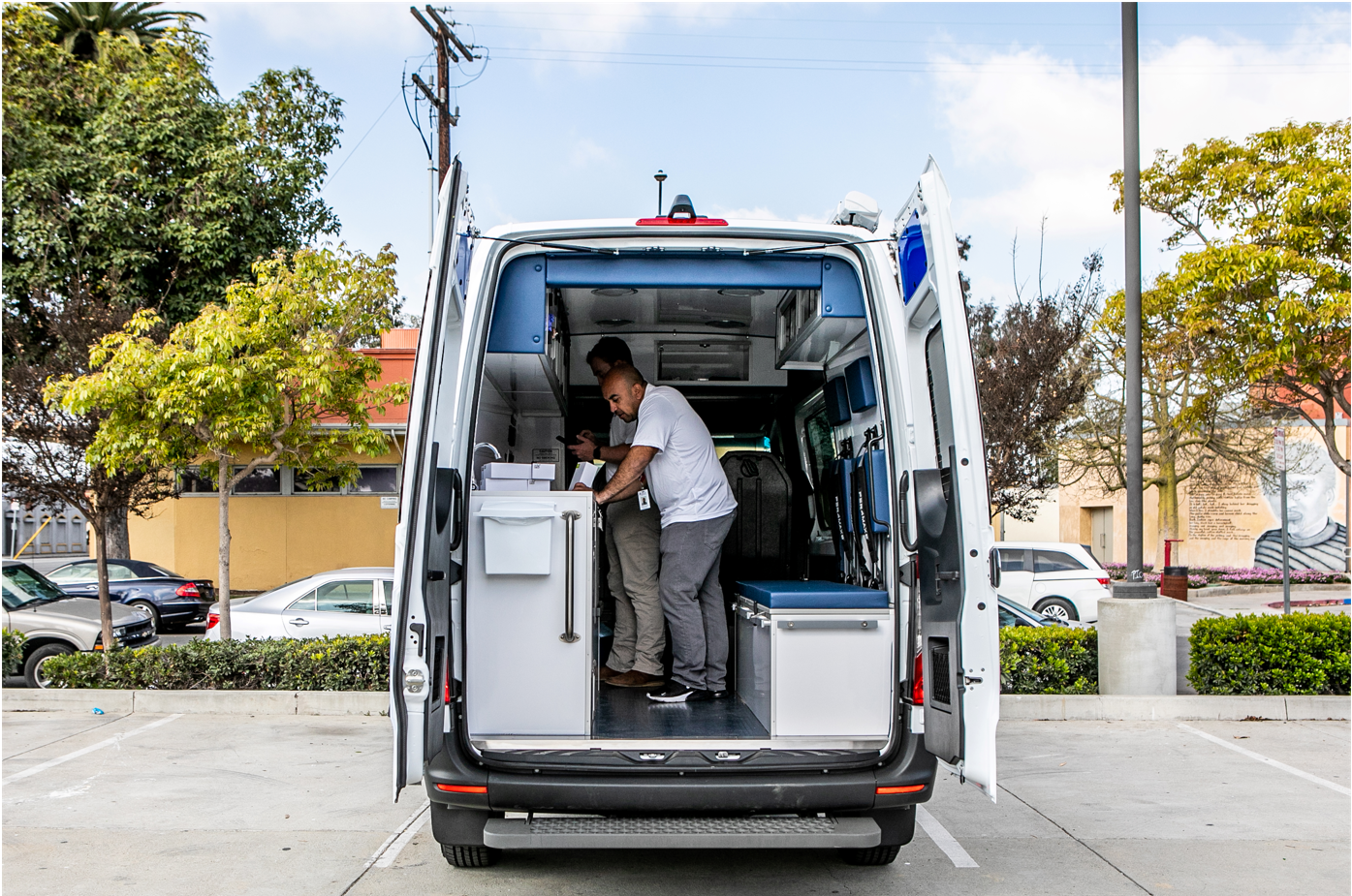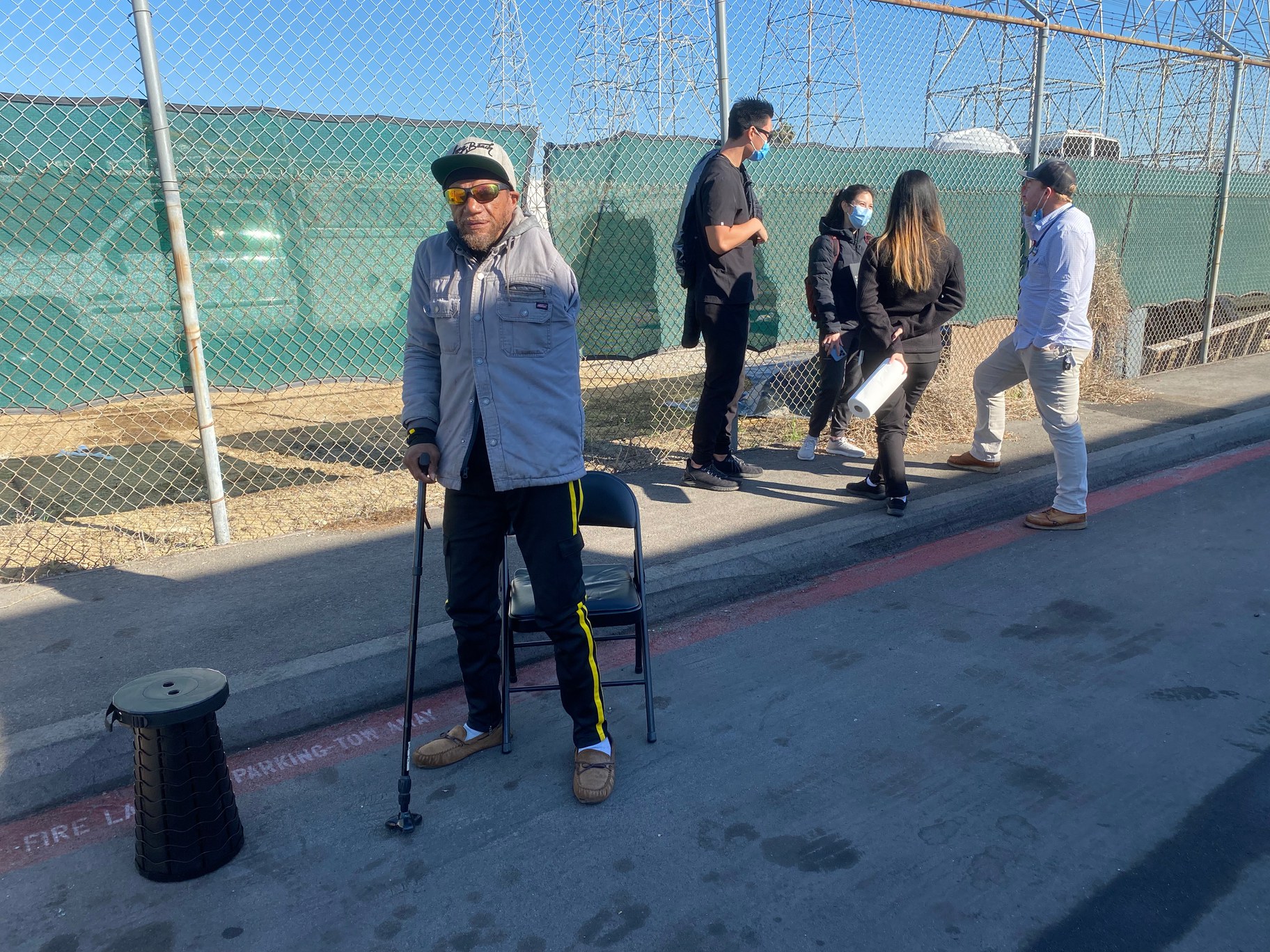For George Godfrey, getting to doctor’s appointments used to be a literal pain. The wiry, soft-spoken 60-year-old, who lives at a homeless shelter in Long Beach, doesn’t have a car, and needs a cane to get around due to bad knees and the arm he lost in childhood. Because of this, trips to the clinic were a tedious affair.
“I hurt,” he says. “I can't get around and do some of the things that I would like to do because I'm getting slower.”
Things got a little easier for Godfrey after he met the team from Healthcare in Action seven months ago. The medical group specializes in street medicine, a growing field that allows doctors to meet — and treat — unhoused people where they are.
Its five-member team makes daily rounds in Long Beach, in a Sprinter van-turned-clinic that’s decked out with everything from an EKG machine to a mini pharmacy. It allows them to provide care to hundreds of people living outside or in shelters who might not be able to access it otherwise.
“We try to reduce all the barriers to care possible, to try to make sure that they get the appropriate service that they need,” says Physician’s Assistant Ben Kaska.

The Healthcare in Action team drives a retrofitted Sprinter van that’s stocked with medical equipment, testing supplies, and a miniature pharmacy. Photo courtesy of Healthcare in Action.
Mobile medical crews like this one are becoming more common in Los Angeles. That’s because state-level policy changes are making it easier for staff to provide regular care and get reimbursed for it.
While many street medicine teams cropped up during the pandemic to provide COVID care to the county’s nearly 70,000 unhoused residents, those providers struggled to expand their practices after those needs waned — despite the many other pressing health issues that required their attention.
“When you bill Medi-Cal or Medicare, you bill for what you did, and where you did it, which is the place of service code. And there was no place of service code to indicate the street,” says Brett Feldman, co-founder of the Street Medicine program at USC's Keck School of Medicine.
But after facing pushback from Feldman and other providers, California’s Medi-Cal program released new guidelines in November that make it easier for street medicine teams to bill for their services.
Recent state initiatives also make it easier for them to serve as patients’ primary doctors, and to provide “whole person” care that includes physical, behavioral, and social services.
“Already, these policies have just absolutely exploded the number of street medicine programs in the state,” says Feldman.
Over the summer, Feldman conducted a comprehensive analysis of California’s street medicine landscape. Back then, there were about 25 teams in operation — now he knows of at least 45. In Los Angeles alone, he’s watched the number of teams double from six to 12 in months. “[I] seem to be finding new ones almost every day,” he says.
The LA City Council just gave USC’s street medicine program $1 million to expand their partnership with the city. And a county street medicine fleet launched during the pandemic is becoming permanent — they now have 60 full-time staff members and four trucks.
LA County Housing For Health Medical Director Absalon Galat says the new reimbursement rules helped fuel the expansion.
“It did allow us to dream a little bit more for our program, envisioning what the ideal should be,” says Galat.
Having a more reliable source of funding has not just increased the number of street medicine teams — it’s changed the way they operate. Providers can now visit clients more regularly, and some are even beginning to offer more specialized services.
The Healthcare in Action team focuses on treating older adults, who represent one of the fastest-growing groups of unhoused people in Los Angeles. Other teams offer gynecological services, or treatment for chronic illnesses like HIV.

George Godfrey, 60, lives in a shelter in Long Beach. Prior to meeting the Healthcare in Action team, he had a difficult time making it to doctor’s appointments due to transportation and mobility issues. Now they visit him for regular checkups in their mobile clinic. Photo by Zoie Matthew.
Access to regular care can be lifesaving for people who live outside or in shelters. Some have trouble making it to brick and mortar clinics due to lack of transportation, physical disabilities, fear of losing their belongings, or the other day-to-day problems that come along with experiencing homelessness.
“Every day, your primary thought is ‘where am I going to eat today? How will I get my clothes clean? How will I wash my hands? Where will I use the bathroom today?’” says Cindy Manginelli, director of community engagement for the National Healthcare for the Homeless Council. “When life is full of tiny little detail questions like that, then it can be overwhelming to think about, ‘what am I going to do about this wound I have?’”
As a result, many unhoused individuals don’t seek health care at all. Despite the fact that the majority of Californians experiencing homelessness are eligible for Medi-Cal, the state’s free or low-cost insurance program, fewer than a third of those enrolled have ever seen a primary care provider.
Living outdoors and in shelters is hard on the body, and waiting until health issues turn serious can result in extended emergency room visits or mild conditions that become life-threatening. In Los Angeles County, the life expectancy for an unhoused person is around 30 years shorter than that of someone who is housed. Those health issues can also make it harder to get housed again.
“We see a lot of people that their health is what has resulted in homelessness,” says Manginelli. “And their health issues also are what keep them from being able to get back on their feet again.”
In addition to keeping people healthier, these programs also aim to help them navigate the sometimes arduous process of finding permanent shelter. Because, as anyone in street medicine will tell you, the best thing you can do for the health of someone experiencing homelessness is to get them housed.
“We’ve still got to do the big part of advocating for public housing, rent control,” says Galat. “But at least in the meantime, while we work on those long term solutions, there is a system of care.”
